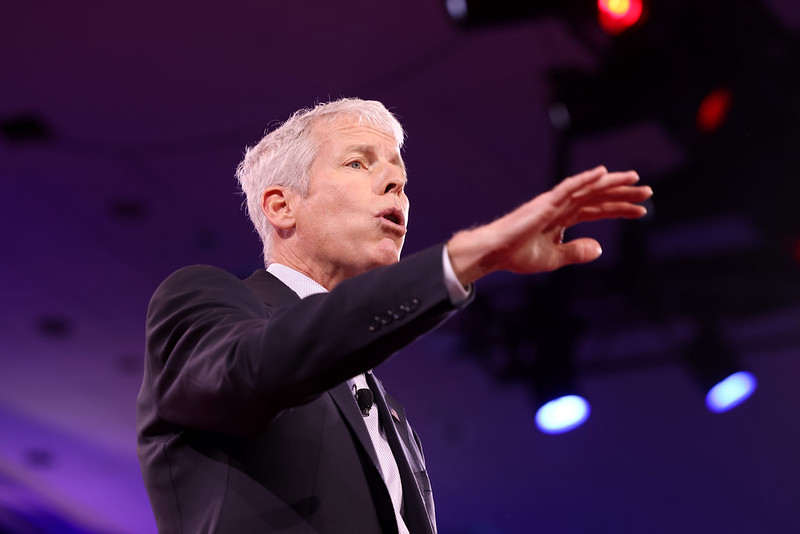Trade associations representing some of the largest dairy companies in the world have coordinated efforts to weaken international standards for how corporations measure their carbon emissions.
Experts say these changes would lead to double-counting of the dairy sector’s emissions cuts, allowing the industry to sell carbon credits to polluting companies for reductions that they are also counting against internal targets.
Consultation documents and position papers reviewed by DeSmog reveal the lobbying effort was led by trade group Innovation Center for U.S. Dairy, whose board includes the two largest dairy companies in the U.S., Dairy Farmers of America and Land O’Lakes.
In the papers, U.S. trade associations like the National Milk Producers Federation, and the International Dairy Foods Association (IDFA) called for major changes in the GHG Protocol, a multi-stakeholder initiative which sets vital global frameworks underpinning how corporate targets are set for cutting emissions.
The standards body is currently undergoing a once-per-decade review of its frameworks and standards.
In response to DeSmog’s findings, an IDFA spokesperson denied lobbying the body and said the group was “consistently opposed” to double counting in the sector, supporting regulatory approaches that were “practical and feasible”.
Subscribe to our newsletter
Stay up to date with DeSmog news and alerts
The meat and dairy industry is responsible for between 12 and 20 percent of all emissions worldwide, and is the largest emitter of methane, a greenhouse gas responsible for a third of global warming to date.
In recent years, the sector has nonetheless ramped up efforts to promote itself as a major contributor to cutting greenhouse gas emissions, by claiming that livestock operations have vast potential to increase the capacity of soil to store carbon.
In early October, representatives of the world’s largest dairy companies dominated discussions at the United Nations Food and Agriculture Organisation (FAO) conference in Rome on sustainable livestock transformation. Dairy companies have also been well-represented at international climate summits in recent years, and are expected to attend this year’s COP30 conference, which kicked off this week in Belém, Brazil.
In a 2023 public consultation on the GHG Protocol, many dairy trade groups submitted near-identical responses calling for more lenient rules on the sales of carbon credits, and repeatedly requested a “seat at the table” in ongoing discussions.
Carbon credits are certificates that represent cuts in carbon emissions by the sellers, which buyers — such as fossil fuel companies — can use to reduce their carbon pollution on paper, a process known as offsetting. The market for agricultural carbon credits could reach $13.7 billion annually by 2050.
Global leaders reached a controversial agreement to enable the trading of emissions reductions through carbon markets at the COP29 climate conference in 2024, and new announcements on their expansion are expected at the upcoming COP30 summit.
The GHG Protocol is also launching new guidance on carbon emissions from the conversion of land, for example from forests to agricultural pastures. In response, the dairy sector has called for changes that would allow more lenient accounting for the carbon emissions created by deforesting land.
Insiders told DeSmog that the GHG Protocol was unlikely to introduce the dairy industry’s favored changes, with the review being steered by academics and environmental groups alongside corporations.
Still, the calls are indicative of wider efforts by the dairy sector “to stop any kind of regulation of the industry,” said Ben Lilliston from the research and advocacy organisation Institute for Agriculture and Trade Policy.
“This is part of the dairy industry’s strategy to slow more concrete action — to avoid the fact we need to transition away from producing so much dairy,” he said. “This is a important fight about who defines the rules.”
‘Sink and Emitter’
In the run up to submitting their consultation responses, the Innovation Center for U.S. Dairy facilitated “task force meetings” that “helped develop an institutional perspective on current GHG Protocol concerns that are especially relevant to U.S. dairy farmers and dairy processors alike”, the documents show.
In the following months, near-identical submissions were made by individual companies including Hilmar Cheese, Land O’Lakes, and Papa Johns, as well as trade groups representing the likes of Nestlé and Danone.
Nestlé’s annual emissions are roughly three times those of Switzerland. The company left an industry initiative to cut methane emissions earlier this month.
The Innovation Center is funded by the U.S. Department of Agriculture’s (USDA) Dairy Research and Promotion Program, better known as the Dairy Checkoff Program, which is funded by a small tax that dairy farmers pay on sales. Small-scale producers have accused the program of promoting the interests of large-scale industrial farms over over their own.
In their responses to the GHG Protocol consultation, multiple dairy groups stated that the industry needed special consideration in the new rules, because it is “uniquely positioned to offer a source of GHG reductions for many other sectors unable to reduce their own footprints internally … as both a carbon sink and emitter”.
Carbon sinks are natural systems, such as soil, that absorb and store carbon — also called carbon sequestration. Farmers can improve how well their pasturage stores carbon for example by using “conservation grazing.” They can also reduce methane emissions from cattle by using special additives in the cows’ feed, or improving their management of manure.
However, dairy companies have repeatedly been accused of over-hyping the potential of these measures to lower their carbon emissions, and thereby justifying expansion of their herds.
A large body of scientific research shows that all forms of meat and dairy production are net emitters, due to large amounts of methane and other potent greenhouse gases emitted by the cattle themselves.
A major study published last year in the journal Nature Communications found it was “not feasible” for the global livestock industry to sequester enough carbon in the soil to cancel out its own planet-warming emissions.
Dairy’s Push for Carbon Credits
Different dairy industry groups used near-identical language to argue that current accounting rules did not adequately recognise the sector’s emissions savings, due to restrictive rules on carbon credits.
Under current GHG Protocol rules, neither dairy farmers nor the buyers of their products can count emissions reductions against their own reported figures if they choose to sell carbon credits for them. However, the sector is lobbying for this to be changed – so that farmers and their buyers as well as the purchasers of the carbon credits would be able to count reductions in their own reporting and to show progress against their targets.
“Dairy farms and other agriculture sectors cannot accurately demonstrate progress toward their own GHG reduction goals if GHG Protocol standards do not acknowledge the credits generated and sold to other sectors”, multiple groups said in the consultation responses.
“Agricultural (and forestry) producers should have the opportunity to maximize their benefits from the important services provided by responsible livestock, farm, soil and ecosystem management.”
However, the suggested amendment could lead to significant double counting against corporate targets, overstating global progress towards vital climate goals.
The sector “is trying a whole host of things to try to maintain business as usual and lower climate scrutiny,” said IATP’s Lilliston. “Any double counting takes away from transparency and accountability” and would paint a falsely positive picture of about carbon cuts.
“The diary industry’s message is, ‘we have this. We’ve got this taken care of.’ They are expert at playing the system”.
The industry’s proposed changes would significantly benefit companies that use or process large amounts of dairy, which cannot currently claim emissions reductions from measures taken by farmers in their supply chain if carbon credits for these have already been sold.
Matt Herrick, executive vice president and chief impact officer for the International Dairy Foods Association, said that given the opportunity, the organisation would be keen to contribute to the protocol further, “beyond submitting comments through a generic online portal”.
The group’s contributions in the consultation were designed “to educate the GHGP about insufficiently clear areas of existing standards identified by various actors throughout the dairy supply chain,” he added, including what he described as “gray areas” in the the protocol’s standards and guidance.
Land Conversion
Changes to the GHG Protocol will affect all sectors. However, the dairy industry was found to have particularly active in efforts to shape accounting for supply chain emissions — by far the largest source for the majority of companies.
The industry also lobbied on new guidance on how companies should account for emissions arising from land management and land use change, which the GHG Protocol is expected to finalise later this year.
Agriculture is the number one driver of land use change and deforestation globally, which have been responsible for around one third of all CO2 emissions since 1750. Eighty percent of all agricultural land is used for livestock.
In addition to the lobbying on carbon credits, a second “task force”, coordinated by the industry-led initiative Pathways to Dairy Net Zero, lobbied to water down the proposed new accounting rules. Efforts were supported by the trade group the Global Dairy Platform, which counts staff from companies including Arla and Saputo on its board.
In a 2023 position paper, the Global Dairy Platform wrote: “The dairy sector urges the GHG Protocol … to allow mass balancing in commodity agriculture supply chain GHG accounting.”
“Mass balancing” is a controversial approach to certifying agricultural goods like soya and dairy where products from more sustainable farms are mixed with conventional products before being purchased by dairy processors — who then buy the product alongside special environmental certificates, allowing them to claim that the ingredient was sustainablysourced.
Under the first draft guidance, published in 2022, the GHG Protocol stated that emissions savings could not be calculated on the basis of mass balance, because products bought by the companies were not physically traceable to the lower-carbon farms.
In response, the Global Dairy Platform warned the GHG Protocol “Unnecessarily restrictive traceability standards present a real tension and disincentive with the dairy sector’s ongoing climate change mitigation work.” Recognition of mass balance systems could be “credible, accurate and workable” for the sector, it argued.
The dairy companies and industry groups referenced in this article did not respond to DeSmog’s requests for comment.
Environmental experts said that recognition of mass balance systems could weaken the impetus for companies to cut emissions in their own direct supply chains.
“Agribusinesses wouldn’t really have to do due diligence to make sure that their actual suppliers have good land management practices in place,” said Mathilde Crepy from ECOS, an NGO specialising in environmental standards.
“It moves away from the physical reality of things and towards wishful thinking,” she added. “It hides the bigger picture.”
Subscribe to our newsletter
Stay up to date with DeSmog news and alerts






